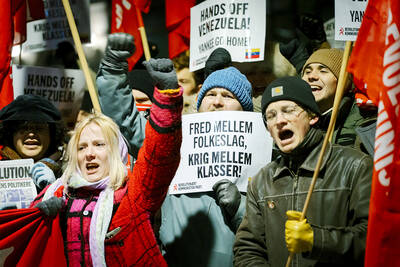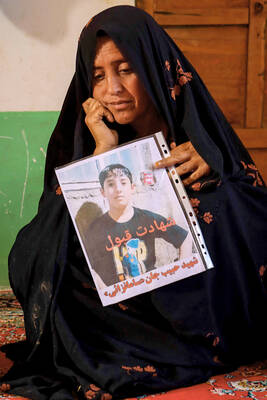The US yesterday wrapped up its first multidomain exercise with Japan and South Korea in the East China Sea, a step forward in Washington’s efforts to enhance and lock in its security partnerships with key Asian allies in the face of growing threats from North Korea and China.
The three-day Freedom Edge increased the sophistication of previous exercises with simultaneous air and naval drills geared toward improving joint ballistic-missile defense, anti-submarine warfare, surveillance and other skills and capabilities.
The exercise, which is expected to expand in years to come, was also intended to improve the countries’ abilities to share missile warnings — increasingly important as North Korea tests ever-more sophisticated systems.

Photo: Mass Communication Specialist Second Class Aaron Haro Gonzalez / The US Navy via AP
Outside of Australia, Japan and South Korea are the only US partners in the region with militaries sophisticated enough to integrate operations with the US so that if, for example, South Korea were to detect a target, it could quickly relay details so Japanese or US counterparts could respond, said Ridzwan Rahmat, a Singapore-based analyst with the defense intelligence company Janes.
“That’s the kind of interoperability that is involved in a typical war scenario,” Rahmat said. “For trilateral exercises like this the intention is to develop the interoperability between the three armed forces so that they can fight better as a cohesive fighting force.”
Such exercises also carry the risk of increasing tensions, with China regularly denouncing drills in what it considers its sphere of influence, and North Korea already slamming the arrival of the USS Theodore Roosevelt carrier group in the Port of Busan — home to South Korea’s navy headquarters and its Gimhae Air Base — in preparation for Freedom Edge as “provocative” and “dangerous.”
On Wednesday, the day after South Korean President Yoon Suk-yeol visited the Roosevelt in Busan, becoming the first sitting South Korean president to board a US aircraft carrier since 1994, North Korea tested what it said was a multiwarhead missile, the first known launch of the developmental weapon, if confirmed.
South Korea’s military said a joint analysis by South Korean and US authorities assessed that the missile launch failed.
The defense cooperation involving Japan and South Korea is also politically complex for Yoon and Japanese Prime Minister Fumio Kishida, due to the lingering resentment over Imperial Japan’s brutal occupation of Korea before and during World War II.
The two countries have the largest militaries among US allies in East Asia — and together host about 80,000 US troops on their territories — but Washington has tended to work with them individually rather than together due to their history.
Kishida’s increase of defense spending and cooperation with South Korea have generally been well received by the Japanese public, but has caused friction with the right wing of his own party, while Yoon’s domestic appeal has weakened, but he has stayed the course.
“South Korea’s shift under the Yoon administration toward improving its relations with Japan has been extremely significant,” said Heigo Sato, an international politics professor and security expert at Takushoku University in Tokyo.
Tensions with North Korea are at their highest point in years, with the pace of leader Kim Jong-un’s weapons programs intensifying, despite heavy international sanctions.
Meanwhile, China has been undertaking a massive military buildup of nuclear and conventional weapons, and has the world’s largest navy. It claims Taiwan and virtually the entirety of the South China Sea as its own territory, and has increasingly turned to its military to press those claims.
Following the exercises in the East China Sea with Japan and South Korea, the Roosevelt is due to sail to the Middle East to help protect ships against attacks by Yemen’s Houthi rebels.
That has made strong security partnerships all the more important, not only with Japan and South Korea, but with Taiwan, Australia, the Philippines and others in the region, and building those up has been a priority for the Biden administration.
“One of the weaknesses of the Chinese navy, despite the number of hulls that they have compared to the Americans, is the fact that they don’t have a network of friendly ports from which they can operate in the event they need to launch a campaign,” Rahmat said. “One of the strengths of the US Navy is not just its ships and its technology, but its ability to call on a vast network of friendly ports and, aware of this strength, they are doubling down by increasing partnerships across the region.”

Indonesia yesterday began enforcing its newly ratified penal code, replacing a Dutch-era criminal law that had governed the country for more than 80 years and marking a major shift in its legal landscape. Since proclaiming independence in 1945, the Southeast Asian country had continued to operate under a colonial framework widely criticized as outdated and misaligned with Indonesia’s social values. Efforts to revise the code stalled for decades as lawmakers debated how to balance human rights, religious norms and local traditions in the world’s most populous Muslim-majority nation. The 345-page Indonesian Penal Code, known as the KUHP, was passed in 2022. It

‘DISRESPECTFUL’: Katie Miller, the wife of Trump’s most influential adviser, drew ire by posting an image of Greenland in the colors of the US flag, captioning it ‘SOON’ US President Donald Trump on Sunday doubled down on his claim that Greenland should become part of the US, despite calls by the Danish prime minister to stop “threatening” the territory. Washington’s military intervention in Venezuela has reignited fears for Greenland, which Trump has repeatedly said he wants to annex, given its strategic location in the arctic. While aboard Air Force One en route to Washington, Trump reiterated the goal. “We need Greenland from the standpoint of national security, and Denmark is not going to be able to do it,” he said in response to a reporter’s question. “We’ll worry about Greenland in

PERILOUS JOURNEY: Over just a matter of days last month, about 1,600 Afghans who were at risk of perishing due to the cold weather were rescued in the mountains Habibullah set off from his home in western Afghanistan determined to find work in Iran, only for the 15-year-old to freeze to death while walking across the mountainous frontier. “He was forced to go, to bring food for the family,” his mother, Mah Jan, said at her mud home in Ghunjan village. “We have no food to eat, we have no clothes to wear. The house in which I live has no electricity, no water. I have no proper window, nothing to burn for heating,” she added, clutching a photograph of her son. Habibullah was one of at least 18 migrants who died

Russia early yesterday bombarded Ukraine, killing two people in the Kyiv region, authorities said on the eve of a diplomatic summit in France. A nationwide siren was issued just after midnight, while Ukraine’s military said air defenses were operating in several places. In the capital, a private medical facility caught fire as a result of the Russian strikes, killing one person and wounding three others, the State Emergency Service of Kyiv said. It released images of rescuers removing people on stretchers from a gutted building. Another pre-dawn attack on the neighboring city of Fastiv killed one man in his 70s, Kyiv Governor Mykola